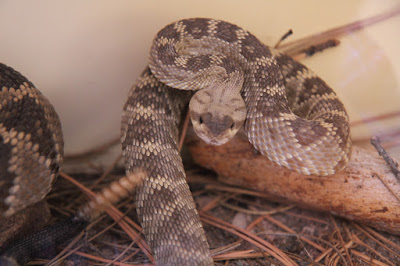I have many favorite spots here for photographing birds, but THE place for reliable raptor sightings is down in the San Simon Valley, about 7 miles east of Faranuf. First, theres's a 4-mile or so drive along the unpaved Stateline Road (called that because it runs on the Arizona/New Mexico border), then on Highway 80, which is where I saw the Golden Eagle. So it's always a thrill driving down the road, because you never know what you might see -- or not see, as in the days when you get "skunked". But this day was a good one, especially for birds-in-flight, and somewhat rare views of the upper part of the bird, not the usual underneath looks. Here's a Swainson's hawk; an interesting fact is that they fly all the way to Argentina to spend the winter --
You can see the obvious differences between the two. Here's the standard shot of the Red-tail as seen from below, though it's executing a nice banking movement --
And earlier, the RT on a perch --
And the Swainson's for comparison --
A few days later, I was in the same area and got a perched shot of another Swainson's. The breast feather pattern threw me off, but my friend and raptor expert Helen said the long folded wings are a good indicator for a Swainson's -- after all, they have to fly to Argentina!
Willow Tank, the 1-acre water impoundment that is being rehabilitated for bird watching, is in the same area. As more ground cover is added, and more holes in the blinds are cut for viewing and photographing without disturbing the wildlife, it can only get better. Here's a resident (or at least a frequent visitor) of Willow Tank, a male Pyrrhuloxia. I caught him nibbling on some greenery --
The sunrises are starting to become more of a "colorfest" again.
On Tuesday I was back manning the desk at the Cave Creek Canyon Visitor Information Center. Work? No --- fun. We have a new exhibit there, thanks to a local herpetologist. I really haven't encountered a snake "in the field" as it were, except for the Patchnose snake in the back yard. Hikers and others are increasingly reporting seeing snakes along the trails, so it's just a matter of time before I see one, too. So to prepare myself for the eventual "confrontation", I'm sharing the VIC with displays of snakes -- and a Gila Monster. And of course they're all alive. There are over 30 species of snakes in the Chiricahuas; snake lovers and herpetologists from all over the world come here to study snakes and other reptiles. The Chiricahua Desert Museum, just across the border in New Mexico, is acknowledged as one of the best places to see exhibits of reptiles in the Southwest. The VIC's display is much smaller, but impressive enough --
What do we have to see? Well, theres a Black-tailed Rattlesnake, which has the widest range of any rattlesnake in the Chiricahuas; you can see them all the way to the tops of the Chiricahuas --
And no, I'm not feeding these fellas; Barney, the "snake whisperer" who sets up these displays every year, is in charge of that. Next up is a Mohave, the most venomous snake to be found in North America. They're found further down in the San Simon Valley, so for the most part I don't have to worry about coming across these around Faranuf --
But I DO have to watch out for these -- the Western Diamondback rattlesnake. They're the most numerous, and are the cause of most rattlesnake bites. Most people, understandably, have an aversion to snakes. But most are beneficial, keeping the rodent population down. And believe it or not, they are just as afraid of humans as we are of them. They'd rather not come across us on the trail, too, and would rather turn, er, tail and slither away. Still, if you surprise one, then there's no telling how it may react. What would YOU do if you came across this while on a hike? --
On April 6 I headed once again over to Willow Tank, and got this shot of Portal Peak and the Chiricahuas south of Portal, as seen from Portal Road --
At Willow Tank, I caused a flock of Mexican Ducks (similar to Mallards) to take wing, with the Chiricahuas in the background - -
There was a meeting of Friends of Cave Creek Canyon that day. One of the items on the agenda was the bee problem at Willow Tank. And they aren't just bees -- they're "Africanized" bees. Mean, nasty, and willing to pursue you if they're so inclined. And Willow Tank is on private property, with public access, so it's in everyone's best interest to get this taken care of ASAP. So a "bee guy" was invited to the meeting. And not just any bee guy, but Reed Booth, killer bee wrangler "as seen on Fox, National Geographic, Discovery and The Food Network (huh?). He's from Bisbee, and has his own website (click here). He's quite the showman, and soon had us all convinced that he was the one to take care of them -- and even threw in free jars of his honey and honey mustard; I got the honey. What does a "bee wrangler" look like? Well, here's the 21st century version, complete with video recorder and sound boom, along with industrial/sci-fi - looking outfits --
I gleaned that photo from the Internet... So that about covers it -- Hawks, Snakes, and Bees. And I leave you with a jar of Killer Bee Honey, made of "pure wildflower and mesquite honey" --
















Great post, Steve!
ReplyDeleteThanks for taking the time out of your busy schedule to read my blog, Wynne! See you Monday...
Delete